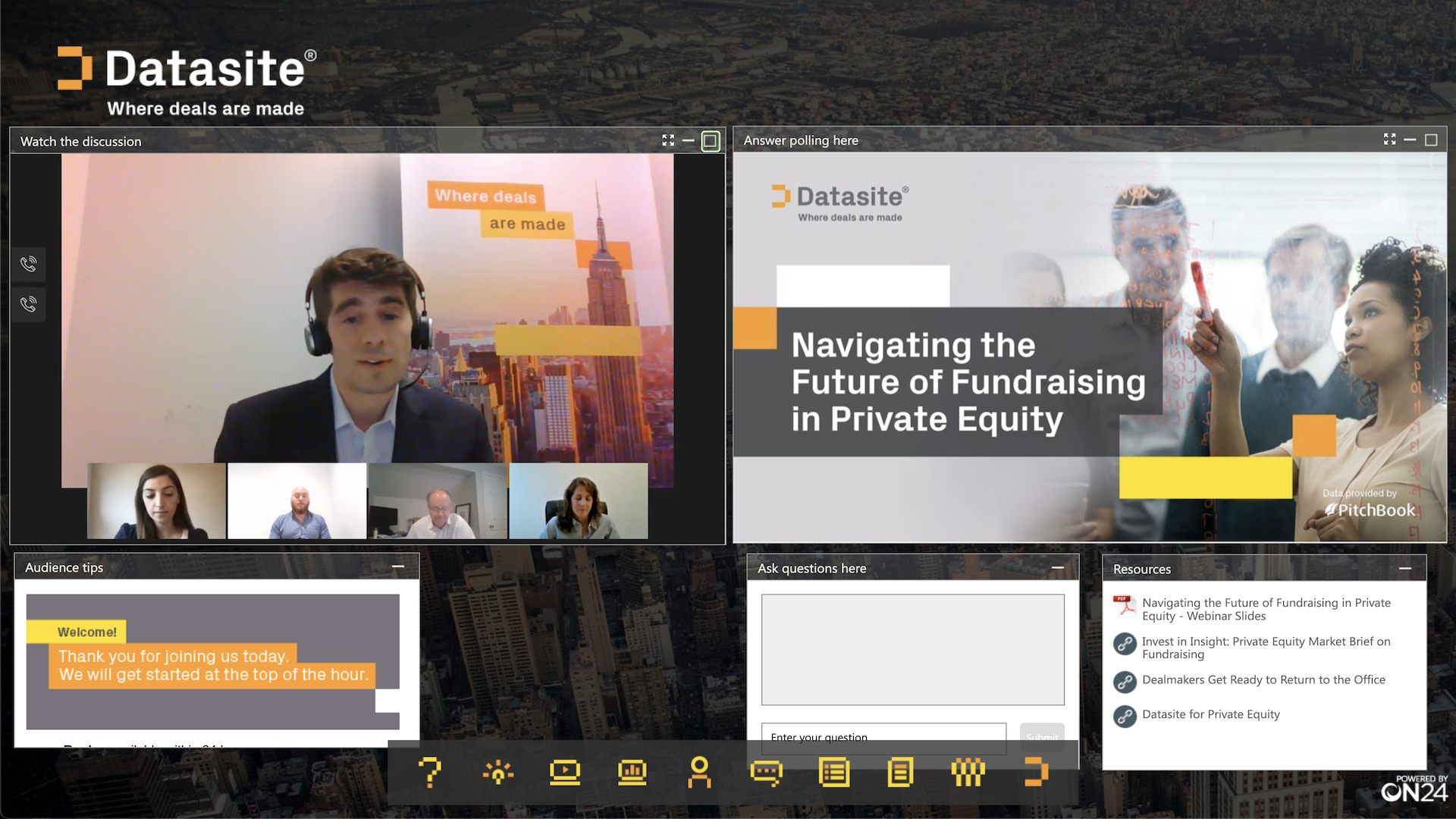How to Make a Great Webinar in 2024

Great webinars don’t have to be Shakespearian in scope or complexity, but they need to tell a great story. How do you do that? With informed, compelling, and dynamic content that brings the audience along for the whole ride.
A webinar’s content is great when it meets both business goals and the goals of the audience. So, if you’re wondering what makes a great webinar,, explore our deep dive into how you can identify in-demand topics, choose the most appropriate webinar format, and deliver a stellar digital experience.
Why does great webinar content matter?
There are people at every company who will argue that webinar content doesn’t really matter. You already got the lead, so mission accomplished, right? Sure, I guess. But also, not at all.
There’s a difference between your demand generation goals (e.g., leads, pipelines, key conversions) and your audience’s goals (e.g., solving a problem or becoming informed about an issue). Great webinar content exists at the intersection of these goals, at the crossroads of our expected outcomes and our audience’s desires.
Once we have the lead, it’s our responsibility as marketers to help our customers solve the problem that prompted them to surrender their email in the first place.
1. Choosing Topics for Your Webinars

There are people at every company who will argue that webinar content doesn’t really matter. You already got the lead, so mission accomplished, right? Sure, I guess. But also, not at all.
There’s a difference between your demand-gen goals (e.g., leads, pipelines, key conversions) and your audience’s goals (e.g., solving a problem, or becoming informed about an issue). Great webinar content exists at the intersection of these goals, at the crossroads of our expected outcomes and our audience’s desires.
Once we have the lead, it’s our responsibility as marketers to help our customers solve the problem that prompted them to surrender their email in the first place.
Don’t do too much
Once you have a list of audience-approved webinar topics, pare each of them down into at least two smaller topics; three is better. One of the biggest mistakes you can make with a webinar is to try to do too much.
For example, “How to Deliver a Successful Webinar” is a terrible topic. There are simply too many critical components of webinar delivery to communicate effectively in one sitting. More importantly, it’s doubtful that your audience would walk away with the clarity and direction to apply anything they learned.
On the other hand, “5 Best Practices for Virtual Product Launches” is an excellent topic because it’s both action-oriented and finite in scope. The title tells your audience exactly what they’ll get out of the event.
2. Crafting a Webinar Story

Your ability to deliver a valuable, authentic and actionable webinar depends on how relevant and emotionally relatable your story is to your audience.
Finding the right webinar format
There isn’t a one-size-fits-all solution when it comes to webinar formats. Every topic has its proper place within a wide array of presentation, panel, conversation, and interview styles. The secret is to find the right format for the declared topic.
What does “right” mean in this context? It implies the format that serves the story best and sets you, your panelists, and your audience up for success.
Here are some examples of webinar formats:
-
- Presenter + Slides
- Conversation + Slides
- Coffee Talks
- News Style
- Interview
- Audience-driven
Your webinar audience’s position in the buyer’s journey is often a good indicator of which format is best for the topic. For example, a presentation format with slides or screen share would be most helpful to instruct customers near the bottom of the funnel on a specific technical operation. However, a conversational format like a webinar interview or coffee talk might better serve as a webinar about a current event or a significant shift in your industry.
You don’t need to stop at one of these formats. Mix and match elements of multiple styles to perfectly tailor your format to your topic and audience. The more thought you put into the format, the easier it will be to deliver a compelling story.
Telling a great story
Every webinar should have a single, specific premise. If you can’t state your webinar’s topic in one sentence, you will be unable to deliver a clear story to your audience.
It all comes down to how you frame the story. Shakespeare isn’t the first literary giant that springs to mind when you think about webinars, but the playwright’s narrative structure is instructive.
In a word: Acts. Build your story in Acts to guide the audience through your ideas while keeping them oriented to your single premise.
Here’s a webinar template structured with Acts:
Act 1: Set up the problem
Act 2: Build the stakes of solving and not solving the problem
Act 3: Resolve the problem
Crafting a great webinar story is like telling a joke. Critical elements must be shared in a specific sequence, with particular inflections, at exactly the right time. Get any of those elements wrong, and it gets awkward.
How long should your webinar content be? The answer entirely depends on how much good content you have. If you can address and solve an audience’s pain point in 20 minutes, why would you aim for 60? Don’t force it; we all have lives. Filler is a killer.
3. Creating Great Webinar Slides

To slide, or not to slide. That is the…last Shakespeare reference in this article. It’s a good question, though. And the answer comes down to the format that best serves your story.
Here are a few slide-friendly formats and circumstances:
- Audio-only webinar
- Complex information
- Instructional content
- When the topic hinges on visual reference points
Remember not to confuse your slide deck for the story. Slides should bolster and enhance the story, but they are not the main attraction. The star of the show is the presenter delivering content.
How to make great slides
We all know a bad slide when we see one. And then you just have to sit there staring at it. We can do better.
The first rule of great slides: resist the temptation to short-cut the process by Frankensteining a deck together. A past webinar on a loosely related topic doesn’t give you the license to assemble a new deck composed of old, disconnected slides. Start with the story, not with the slides.
The second rule of great slides: a blank slide is the best beginning. Use it to outline your entire webinar in bullet points. Once you’ve got the bullet points down, group them into Acts. Once you’ve got your Acts defined, make each bullet point its own slide. Now you’ve got the visual framework for your story.
The third rule of great slides: do everything you can to get your audience into that story. Your narrative should be compelling, relevant, and emotionally relatable for your audience. Use your slides to build interactive inflection points that mobilize your audience alongside you. Polls and questions throughout the webinar are great ways to unite and engage your audience. Don’t leave Q&A for only the very end!
The dos and don’ts of great slides
Here’s a handy list for avoiding being that person known for epically bad slides.
Hard No:
-
- Don’t overdesign your slides. Keep in mind the size of everyone’s screen.
- Don’t show tons of details. (Again, screen size.)
- Don’t force the eye to do too much with animations and animated transitions.
- Don’t go nuts with text. If your topic is best served in a book format, don’t do a webinar.
- Don’t pitch until it’s time to pitch. Your audience trusts you, so keep it that way.
Emphatic Yes:
-
- Use images to make emotional connections. Yes, cute puppies and kittens are winners no matter the context.
- Use bullet points to emphasize main points.
- Use screen share. We love demos in real-time.
- Use supplemental resources, links, downloads, other webinars, a landing page, and anything else to add value. Surround your audience in content.
- Use video to tell your story.
4. Using Video In Webinars

There are so many ways to use video in webinars. Unlike a screen share or slides, video offers a multi-media opportunity to enrich any topic. With a single video, you can transform traditional formats into dynamic digital experiences. Video allows the presenter to introduce rich concepts that couldn’t be included any other way.
Here are some ideas for using video in your webinars:
-
- Special guest interviews
You can conduct and record the interview anytime before the live webinar. Set up the interview with slides and then play a part of it during the webinar. Interviews allow you to expand the presenter format but without the hassle of coordinating an entire live panel.
-
- Integrate video clips throughout the webinar
Consider adding a short video to each Act of your webinar story. For audiences at the top of the funnel especially, a video will elicit more of an emotional response than a static slide.
5. Reusing Webinar Content

Reusing webinar content doesn’t require an elaborate operation. To effectively repurpose old webinar content for a new digital experience, there are a few methods that work well:
-
- Deliver a new webinar with existing content.
If you change anything here, it might be minor updates to the copy. But otherwise, this method is like a Disneyland ride: a delight, no matter how many times you’ve already done it.
-
- Delivering an old webinar as a simulive
A simulive means that you promote and present a previously-recorded webinar as a live event. Just be sure to check that the audience-interactive elements, like a dated poll, won’t ruin the simulive illusion.
-
- Delivering a new live webinar or webcast with elements of old material
Again, we’re not Frankensteining a cut of the webinar. We’re starting with the story, and perhaps we happen to use good material that we created in the past.
-
- Turning pre-recorded webinars into “always-on” content
This method is excellent for evergreen topics. Just like videos on your site, always-on webinars offer your audience endless options for self-serve education.
Whichever content repurposing method you choose, the key to success is marketing. For any of these options, you should start promoting on inbound channels at least two weeks in advance of the event.
6. Use the Right Webinar Platform
The right webinar platform makes all the difference in the world for any digital marketer seeking a solution that impacts their business needs. Marketers should search for a solution that:
-
- Empowers you to fully brand and customize your webinar consoles and digital experiences
- Fully integrates with existing sales and martech stacks
- Provides actionable insights for marketing and sales that are powered by first-party data
- Helps create engaging and ongoing buying journeys
Now, we may be a bit biased, but the ON24 webinar capability does tick all of the boxes. Its engagement features, powerful reporting tools and its ability to help marketers scale with artificial intelligence, is a compelling offer for any growth-oriented marketer — especially when compared to the competition. If you’d like to see what your peers think of the ON24 difference, click here.
Summary
Creating great webinar content requires forethought, a little empathy for your audience, an excellent webinar platform, and the tools to tell a fantastic story.
Here are the biggest takeaways from our discussion:
-
- Keep your audience’s goals top-of-mind. Know what they want and build content that will help them get there.
- Choose a webinar format that serves the story best
- Keep the narrative simple. You are the story, not the slides.
- Use video to enhance and enrich the story.
- Surround the audience with content so that they can continue to educate themselves
- Incorporate webinar repurposing into your marketing strategy.
- Don’t let the story end! Keep the webinar going with on-demand content.